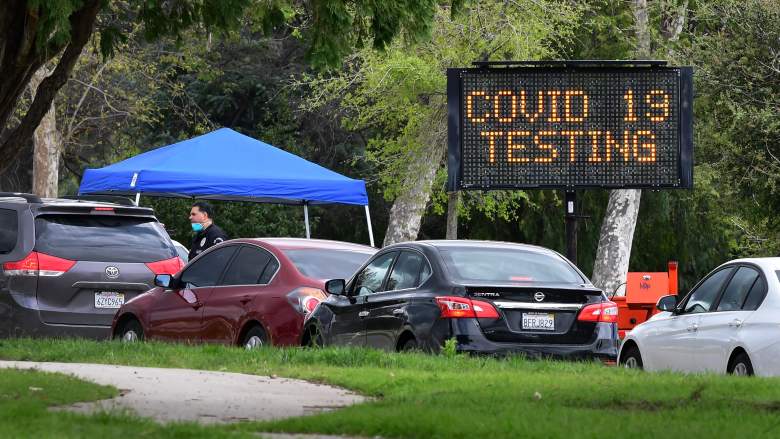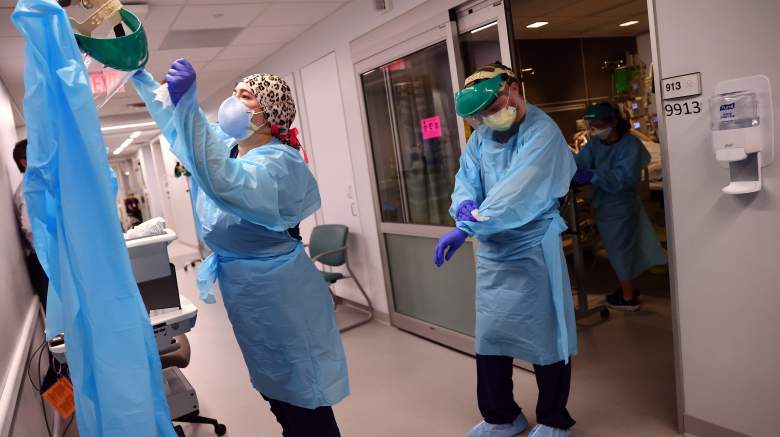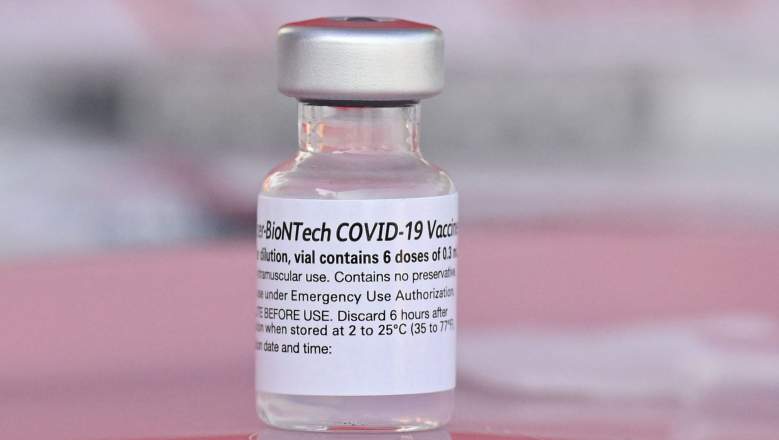
Getty If someone in your house has COVID-19, will you get it?
If someone in your house has COVID, will you get it? A lot of people are wondering the answer to this question as the infectious Omicron variant spreads.
The answer: Not necessarily, but you should take precautions, as studies have found that household transmission among family members is common. In certain instances, the Centers for Disease Control and Prevention recommends that you quarantine “to prevent transmission of COVID-19 by keeping people who have been in close contact with someone with COVID-19 apart from others.” There are steps you can take to reduce the chances of infection, though.
Here’s what you need to know:
To Reduce Chances of Transmission, CDC Recommends Creating a ‘Sick Room’ for the Infected Household Member

Getty A police officer mans the entrance to a coronavirus (COVID-19) testing center in Hansen Dam Park on March 25, 2020 in Pacoima, California.
CDC recommends a sick room for the infected household member and suggests they should use a separate bathroom. The CDC writes:
Isolation is used to separate people with confirmed or suspected COVID-19 from those without COVID-19. People who are in isolation should stay home until it’s safe for them to be around others. At home, anyone sick or infected should separate from others, or wear a well-fitting mask when they need to be around others. People in isolation should stay in a specific ‘sick room’ or area and use a separate bathroom if available. Everyone who has presumed or confirmed COVID-19 should stay home and isolate from other people for at least 5 full days (day 0 is the first day of symptoms or the date of the day of the positive viral test for asymptomatic persons). They should wear a mask when around others at home and in public for an additional 5 days. People who are confirmed to have COVID-19 or are showing symptoms of COVID-19 need to isolate regardless of their vaccination status.
How long should the sick person isolate? “If you had COVID-19 and had symptoms, isolate for at least 5 days. To calculate your 5-day isolation period, day 0 is your first day of symptoms. Day 1 is the first full day after your symptoms developed. You can leave isolation after 5 full days,” CDC recommends.
Michigan Health has 14 tips for living with someone with COVID. They include “Clean your hands often and thoroughly with soap or alcohol rub” and “Clean surfaces with soap or disinfectants.”
They add:
The sick person should stay in a bedroom with a door if at all possible, and not come out except to go to the bathroom. No one else should spend time in that room more than absolutely necessary. Children and pets should stay out. Keep a window open in the sick room if possible, to keep air circulating. Provide tissues.
The blog recommends you keep your laundry separate as well.
Transmission of COVID Among Household Members Was Common in One Study

Mario Tama/GettyClinicians depart a patient room after re-positioning a COVID-19 patient into the supine position in the Intensive Care Unit (ICU) at Lake Charles Memorial Hospital on August 10, 2021 in Lake Charles, Louisiana.
How common is household transmission of COVID-19? A 2020 journal article called “Transmission of SARS-COV-2 Infections in Households — Tennessee and Wisconsin, April–September 2020” attempted to answer this question.
The study found that:
…Transmission of SARS-CoV-2 among household members was common, and secondary infection rates were higher than have been previously reported…Secondary infections occurred rapidly, with approximately 75% of infections identified within 5 days of the index patient’s illness onset. Secondary infection rates were high across all racial/ethnic groups. Substantial transmission occurred whether the index patient was an adult or a child.
This study suggests:
Because prompt isolation of persons with COVID-19 can reduce household transmission, persons who suspect that they might have COVID-19 should isolate, stay at home, and use a separate bedroom and bathroom if feasible. Isolation should begin before seeking testing and before test results become available because delaying isolation until confirmation of infection could miss an opportunity to reduce transmission to others. Concurrently, all household members, including the index patient, should start wearing a mask in the home, particularly in shared spaces where appropriate distancing is not possible.
Another study found an infection rate in households of 32 percent. This study was called “Household Transmission of Severe Acute Respiratory Syndrome Coronavirus 2 in the United States: Living Density, Viral Load, and Disproportionate Impact on Communities of Color.”
“We think this number is actually much higher,” says Jessica Lin, MD, the study’s senior author and assistant professor in the Division of Infectious Diseases at the University of North Carolina at Chapel Hill School of Medicine, told Gillings School News. “Sometimes, we were getting to households to test people four or five days after the initial COVID-positive person showed symptoms. By that time, a lot of household members were already infected. But, because that infection happened before we got there, we couldn’t include it in our data.”
Should You Quarantine Too?

GettyA vial of Pfizer-BioNTech Covid-19 vaccine is seen at a pop up vaccine clinic in the Arleta neighborhood of Los Angeles, California, August 23, 2021.
Whether you need to quarantine depends on whether you had “close contact” with the infected person in your household.
The CDC defines close contact as: “Someone who was less than 6 feet away from an infected person (laboratory-confirmed or a clinical diagnosis) for a cumulative total of 15 minutes or more over a 24-hour period (for example, three individual 5-minute exposures for a total of 15 minutes).”
Even in the case of close contact, the CDC says you don’t need to quarantine if:
You are ages 18 or older and have received all recommended vaccine doses, including boosters and additional primary shots for some immunocompromised people.
You are ages 5-17 years and completed the primary series of COVID-19 vaccines.
You had confirmed COVID-19 within the last 90 days (you tested positive using a viral test).
CDC recommends:
You should wear a well-fitting mask around others for 10 days from the date of your last close contact with someone with COVID-19 (the date of last close contact is considered day 0). Get tested at least 5 days after you last had close contact with someone with COVID-19.
READ NEXT: OnlyFans Model Accused of Stabbing Boyfriend